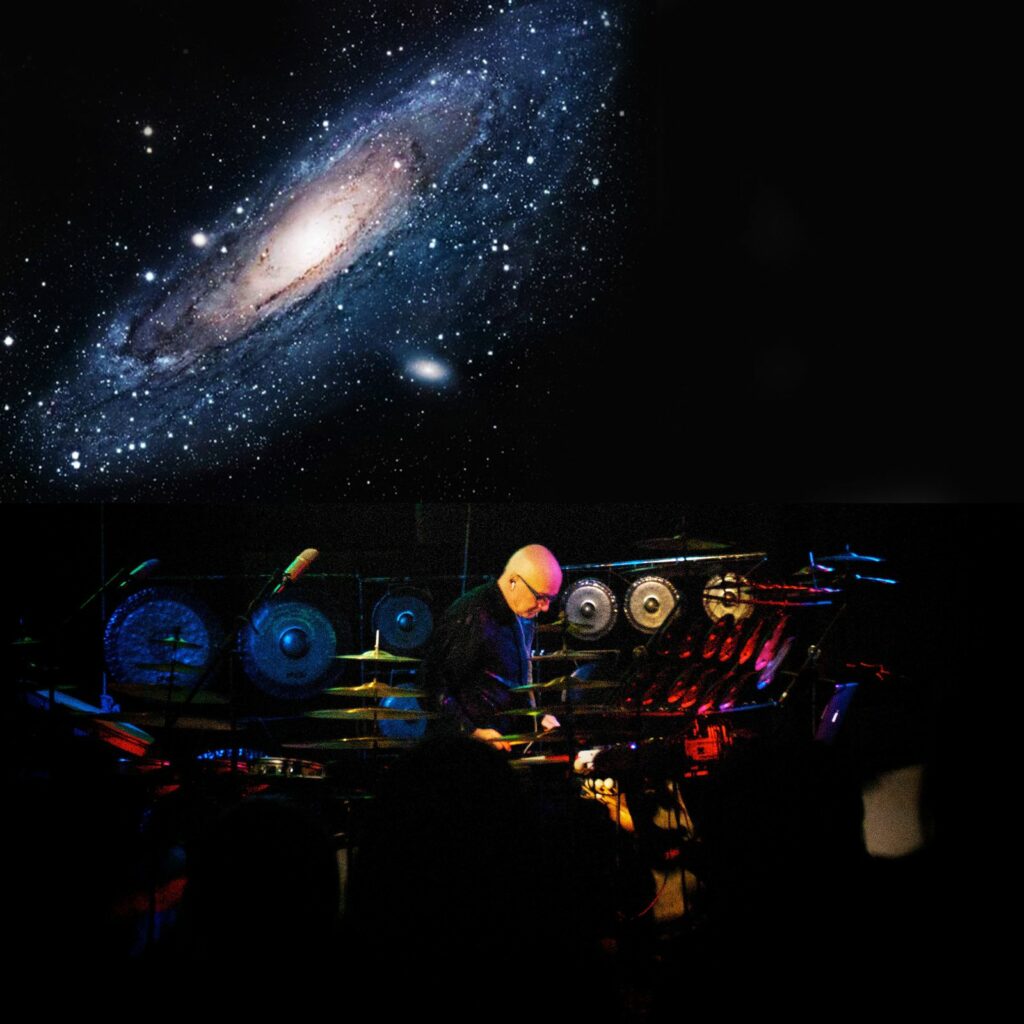A MULTIMEDIA PROJECT
BY
ANDREA CENTAZZO AND MICHELE VALLISNERI
Following the success over a 4-year run of their first project, Einstein’s Cosmic Messengers (sponsored by LIGO and Caltech, with images and video from NASA and ESA) composer/percussionist Andrea Centazzo and scientist/writer Michele Vallisneri return with a new project celebrating with words, music, and images the centenary of Einstein’s theory of General Relativity
The project, produced and presented in its first version by the Nobel Prize for Physic Kip Thorne, is structured as a multimedia live solo concert, interspersed with live spoken narrations; it aims to take the audience on a journey to Mars (starting from the suggestions of ancient mythologies, and ending with NASA’s latest and most exciting discoveries), and way beyond, into the unseen Universe, as explained by Einstein’s theory, and as revealed by current efforts to detect gravitational waves.
After the premiere of Einstein’s Cosmic Messengers, Caltech’s California Tech newspaper praised: “The bridge between science and art has never been easy to construct, but on Thursday night we may have gotten as close as we’re ever going to get.” Tides of Gravity, is infused with the same spirit and ambition. The audience will learn the amazing facts we’re discovering about Gravitational Waves; how we can use the signals from dead stars to detect minute fluctuations in the very fabric of the Universe; how Einstein’s General Relativity, just now a hundred years old, revolutionized our notion of the nature of time; and how our failure to detect any intelligent communications from the Galaxy may have implications on the destiny of our species. Vallisneri will weave unexpected and thought-provoking tales of our Cosmos; Centazzo will illuminate and transcend with live percussive and electronic music and stunning HD videos.
Why gravitational waves? These elusive signals are ripples in the fabric of space and time produced by violent events in the distant universe. Albert Einstein predicted their existence in 1916, but only in the last two decades did we achieve the technology to detect them and thus gain unique insight in the dark side of the Universe. This technology is expressed most exquisitely in LIGO, a facility supported by more than 500 researchers in the world scientific community, and a vital member in a developing global network of gravitational-wave observatories. LIGO’s measurements illuminate the fundamental nature of gravity and throw open an entirely new window onto the Universe, affording views of previously inaccessible such as the coalescence of black holes and neutron stars.

Michele Vallisneri
A theoretical physicist at NASA’s Jet Propulsion Laboratory, Vallisneri received his PhD in physics from Caltech in 2002. He is a member of the LIGO Scientific Collaboration, the NANOGrav pulsar-timing consortium, as well and was the Deputy Project Scientist for LISA, a planned space-based gravitational-wave observatory. His research interest span the detection, analysis, and interpretation of gravitational-wave signals, computational physics, and the creative interface of science and art, as explored through music, visualization, and computer programs.
Andrea Centazzo
In his more than 30 years of career, composer, conductor, percussionist and video artist Centazzo has performed in more than 1500 concerts in Europe and the United States and he has received a number of international music and video awards. For 20 years now, Centazzo has been creating multimedia experiences that combine live music with video images, blending traditional instrumentation with the latest digital technology. Most recently, he received broad critical and popular acclaim for his multimedia projects Mandala (inspired by the Buddhist Universe) and Eternal Traveler (inspired by Leonardo Da Vinci) and ECM (written with Vallisneri), appearing in TV broadcasts at CBS, KPFK, and Rai, and in several international magazines.
Credits
Music and video by A. Centazzo.
Concept by A. Centazzo and M. Vallisneri.
Images, video, and animations: A. Centazzo, California Institute of Technology (LIGO Lab; Division of Physics, Mathematics, and Astronomy; Public Relations), ESA (Hubble Information Center), LIGO Scientific Collaboration, Max Planck Institute for Gravitational Physics/Albert Einstein Institute, NASA (Beyond Einstein, Chandra), National Science Foundation (Einstein’s Messengers), Space Telescope Science Institute (Hubble Heritage Project), Teatro Comunale di San Giovanni in Persiceto, M. Vallisneri.